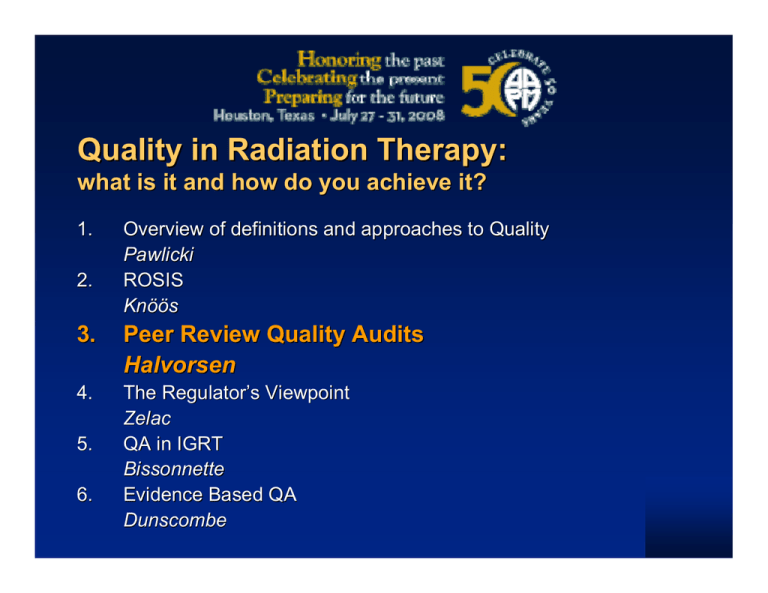Quality in Radiation Therapy: 3. Peer Review Quality Audits
advertisement

Quality in Radiation Therapy: what is it and how do you achieve it? 1. 2. Overview of definitions and approaches to Quality Pawlicki ROSIS Knöös 3. Peer Review Quality Audits Halvorsen 4. The Regulator’s Viewpoint Zelac QA in IGRT Bissonnette Evidence Based QA Dunscombe 5. 6. Peer reviews for clinical physicists: What / Why? What: A review by an impartial, experienced colleague focused entirely on providing the incumbent physicist with constructive suggestions for improving quality & safety. Why: – – – – Safety Quality Reimbursement Regulatory requirement Key motives (Other catalysts) Peer reviews to enhance & validate quality • Recent developments favoring peer reviews for physicists – – – – – • Regulatory Payors Professional organizations IoM reports ABR MOC Types of clinical physics peer reviews – – – – Accrediting organizations (ACR, ACRO) Formal, private reviews (TG-103) RPC audit ABR-qualified, AAPM-operated PQI program? Regulatory example: NY state Payor pressure: Blue Cross AAPM recommendation: IoM report: “Recommendation 7.2: Performance standards and expectations for health professionals should focus greater attention on patient safety. Health professional licensing bodies should: (1) Implement periodic reexamination and relicensing of doctors, nurses and other key providers, based on both competence and knowledge of safety procedures, and (2) Work with certifying and credentialing organizations to develop more effective methods to identify unsafe providers and take action.” ABR’s MOC: ACR Accreditation: • Comprehensive review of entire clinical program – – – – • Physicians must agree to be reviewed as well Somewhat expensive ($9K) The reviewed entity is the organization Formal process to ensure the report is unbiased Physics component: – – – – Benchmarked against TG recommendations & ACR standards Review of calibration & commissioning reports, instruments One-day on site review by an experienced physicist Includes review of clinical charts & treatment plans / dose calcs Physicist peer reviews per TG-103: Context: Main components: • Formal arrangement with an outside QMP. • Annual review if new equipment, new services, or physics staffing changes; otherwise every 3 years. • Review follows a defined scope and format to ensure some level of consistency and effectiveness of reviews. • Review includes an on-site visit with careful assessment of instruments, calibration records, treatment planning / dose calculation conventions, and physics documentation. • Formal written report addressed to the physicist, with recommendations for improvement. Topics reviewed: • Independent verification of accelerator outputs – verify TLD reports within past year, or perform independent measurement. • Chart audit of ≥5 randomly selected patient charts, with emphasis on dosimetry calculations, physicist check/approval, accurate treatment history record, and tx plan documentation. • Review of the QC & QA programs in place and consistency of implementation. • Assess physics staffing/coverage relative to the scope and volume of clinical services provided. • Assess support for instrumentation, service agreements, and professional development. Checklists: Checklists: Checklists: Checklists: Summary: • Peer reviews for quality improvement are becoming increasingly common in medicine, and medical physics is no exception. • The AAPM has formulated a mechanism for such reviews in clinical radiotherapy physics. • From personal experience as both a reviewer and the reviewed, the process is an effective component of a quality improvement program and does not unduly disrupt the incumbent’s clinical work flow.
